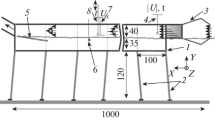Abstract
The influence of the roughness of the underlaying water surface on turbulence is studied in a stably stratified boundary layer (SSBL). Direct numerical simulation (DNS) is conducted at various Reynolds (Re) and Richardson (Ri) numbers and the wave steepness ka. It is shown that, at constant Re, the stationary turbulent regime is set in at Ri below the threshold value Ri c depending on Re. At Ri > Ri c , in the absence of turbulent fluctuations near the wave water surface, three-dimensional quasiperiodical structures are identified and their threshold of origin depends on the steepness of the surface wave on the water surface. This regime is called a wave pumping regime. The formation of three-dimensional structures is explained by the development of parametric instability of the disturbances induced by the surface water in the air flow. The DNS results are quite consistent with prediction of the theoretical model of the SSBL flow, in which solutions for the disturbances of the fields of velocity and temperature in the wave pumping regime are found to be a solution of a two-dimensional linearized system with the heterogeneous boundary condition, which is caused by the presence of the surface wave. In addition to the turbulent fluctuations, the three-dimensional structures in the wave pumping regime provide for the transfer of impulse and heat, i.e., the increase in the roughness of the water–air boundary caused by the presence of waves intensifies the exchange in the SSBL.
Similar content being viewed by others
References
C. W. Fairall, E. F. Bradley, and J. E. Hare, J. Clim. 16, 571–591 (2003).
P. P. Sullivan, J. C. McWilliams, and C.-H. Moeng, J. Fluid Mech. 404, 47–85 (2000).
D. Yang and L. Shen, J. Fluid Mech. 650, 131–180 (2010).
O. A. Druzhinin, Yu. I. Troitskaya, and S. S. Zilitinkevish, J. Geophys. Res. 117 (C00J05), 1–16 (2012).
A. S. Monin and A. M. Yaglom, Statistical Hydromechanics (Gidrometeoizdat, St. Petersburg, 1992), Vol. 1, p. 694 [in Russian].
O. Flores and J. J. Riley, Boundary-Layer Meteorol. 139, 241–259 (2011).
Yu. I. Troitskaya, E. V. Ezhova, D. A. Sergeev, A. A. Kandaurov, G. A. Baydakov, M. L. Vdovin, and S. S. Zilitinkevich, Nonlin. Processes Geophys. 20, 841–856 (2013a).
Yu. L. Troitskaya, E. V. Ezhova, and S. S. Zilitinkevich, Nonlin. Processes Geophys. 20, 825–839 (2013b).
A. D. D. Craik, J. Fluid Mech. 50, 393–413 (1971).
M. I. Rabinovich and D. I. Trubetskov, Introduction in the Theory of Vibrations and Waves (Nauka, Moscow, 1984) [in Russian].
Author information
Authors and Affiliations
Corresponding author
Additional information
Original Russian Text © O.A. Druzhinin, Yu.I. Troitskaya, S.S. Zilitinkevich, 2016, published in Doklady Akademii Nauk, 2016, Vol. 466, No. 1, pp. 92–96.
Rights and permissions
About this article
Cite this article
Druzhinin, O.A., Troitskaya, Y.I. & Zilitinkevich, S.S. Direct numerical simulation of a turbulent stably stratified air flow above a wavy water surface. Dokl. Earth Sc. 466, 54–58 (2016). https://doi.org/10.1134/S1028334X16010025
Received:
Published:
Issue Date:
DOI: https://doi.org/10.1134/S1028334X16010025




